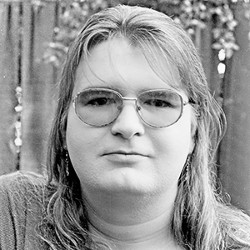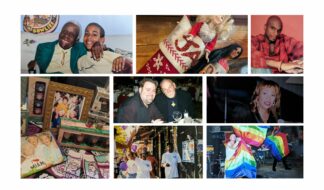By Gwendolyn Ann Smith

I've long dedicated my like to transgender causes. In 1993, before the internet had really become "a thing," I was fighting America Online to allow open discussion of transgender issues within their service, and then managed a transgender issues area there. I served as part of several transgender organizations. I built and managed several transgender information websites throughout the 1990s and 2000s, and still serve as managing editor for http://Genderfork.com. Of course, I'd be remiss if I did not mention the nearly 16 years of Transmissions columns I have written.
Yet there is one thing I will forever be most known for, and that is the Transgender Day of Remembrance.
It started in anger, as I heard of yet another transgender murder and saw a community seemingly unaware that our lives were being taken from us. I started a website, under a banner featuring George Santayana's famous quotation, "Those who do not remember the past are condemned to repeat it." Beyond that, an ever-growing list of names of those killed due to anti-transgender violence and prejudice.
This led to a street protest in San Francisco that, with the help of Penny Ashe Matz in Boston, became the Transgender Day of Remembrance. While others are as much a part of it today, I'm still proud to have been there that first year in the late 1990s, shivering my way through a wet, cold San Francisco night.
The Nov. 20, 2016 will see the honoring of the 17th Transgender Day of Remembrance.
A lot has changed in those years. Yes, I've got a lot grayer than I was then, but that's to be expected. What's really changed is the transgender community itself.
At the time we started, just getting transgender support groups to acknowledge that transgender people were being murdered and to honor their passage was a challenge. While a few of the so-called "safer" cities would hold large candle-lit marches, many others held events behind closed doors, with only a handful of people quietly memorializing those we'd lost.
At the time, we were at the very end of Bill Clinton's presidency, with the second Bush presidency right around the corner. GLBT rights were still in an era of "Don't Ask, Don't Tell," and the next president would not necessarily be favorable — especially to transgender folk. Many of us were outed to employers thanks to the "Gender No-Match" letters the Social Security Administration sent out under George W.
After Bush, and into Obama, the world changed. Transgender people have — in spite of recent difficulties over public accommodations and such — become a part of the popular consciousness like never before. We're on America's television screens, whether it be in reality shows like "I Am Jazz," or on Fox for the reboot of "The Rocky Horror Picture Show," to name just two examples.
Likewise, the community back then was a small one, largely closeted, and more than a little hegemonic. It was largely white, largely older, largely cross dressers and transsexuals. Today, that has changed as we see more people exploring new avenues with gender, and more people of color and trans youth. There are still huge steps to be made here, but we're moving in the right direction.
But with greater visibility has come an unmistakable reality. In 17 years of the Transgender Day of Remembrance, we have not seen a decline of anti-transgender murders. Indeed, in recent years, we've seen the number of murders trending upwards, not down, as transgender visibility — and the backlash against — grows.
So many on the right have set out to demonize transgender people after they lost the battle over marriage equality. Likewise, we've been an election year issue, particularly in North Carolina and Texas. As fears against transgender people in restrooms have grown, so has the threat of violence against us and all who do not conform to outdated, rigid standards of gender.
We're being killed at a rate greater than two per month in the United States. Worldwide, that becomes more than two each day, particularly in Brazil. This is simply unacceptable. I would also be utterly remiss if I did not also remind people that it is transwomen of color who remain most at risk in the U.S., and that we cannot ignore issues of racism and sexism in any discussion of anti-transgender murders. This is an intersectional fight.
Our community is at another of many crossroads. With the 2016 election season behind us, and an uncertain road ahead, it is once again up to each of us to rise. We need to band together and move forward. We need to continue to secure our unalienable rights. I hesitate to add that one right stands above all else that we need to fight for: the right to exist.
Being aware of these murders has never been enough. I've always been a firm believer in the words of Mother Jones, and have applied them to the Transgender Day of Remembrance many times: "Pray for the dead and fight like hell for the living." We set aside this one day to mourn — but take all the other 364 days and fight, keep them in your heart, and do what you can to ensure that not one more falls.
So on the 20th of November, as we have for nearly two decades, honor our fallen dead. On the 21st, and thereafter, we continue the struggle, and we make this world a better one for all transgender people.
Remember.










